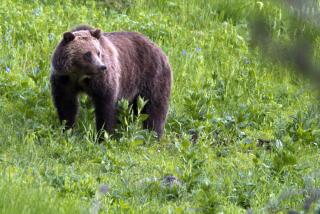‘NATIONAL GEOGRAPHIC’ SPECIAL : ‘GRIZZLIES’: KILLERS OR TEDDY BEARS?
- Share via
Wildlife biologist Doug Chadwick cracked a wry smile when he was asked how the average person reacts to the grizzly.
“As a (park) ranger once told me,” he said, “half the people think they are killers. The other half think they are teddy bears.”
Hug ‘em or hate ‘em, “The Grizzlies” are the subject of a PBS “National Geographic” special that bears attention. Narrated by actor Peter Coyote, the hourlong documentary airs tonight at 7:30 p.m. (50) and 8 p.m. (28)(15)(24).
In most instances, the word awesome is an apt adjective for a grizzly. One in particular named Griz, who weighs in at 700 pounds and rises nearly nine feet, rumbled through town last week to promote the public television program.
The furry brown Griz has appeared in a host of TV series and commercials. For his part, Chadwick wrote a Geographic feature about grizzlies last year.
Chadwick said the program introduces viewers to the individuality of the widely misunderstood “critters” and the importance of their coexistence with us.
The bottom line of tonight’s telecast is that the grizzly is losing its territorial war with man, who is constantly expanding his environment.
In the lower 48 states where the grizzly is considered a threatened species, there are nearly 900, with about 250 to 290 protected in Yellowstone Park and another 50,000 in Alaska.
Among the bare facts to be gleaned about grizzlies in tonight’s program:
--Contrary to the widespread belief that they are aggressive carnivores, these creatures are omnivores, whose diets consist mainly of vegetation.
--Despite its bulk, a grizzly possesses surprising speed; it can dash 50 yards in a mere three seconds.
--And while the female will fiercely protect her cubs, the male will eat them without hesitation.
While there is “tremendous support for preserving the bears,” Chadwick asserted, there is the confounding question of how to successfully go about the task.
“The needs of the grizzly are huge and diverse,” he said. “They need the valleys, the side of slopes during huckleberry season and the surrounding area.”
Noting that a grizzly requires good wilderness country for survival, Chadwick added: “If there’s room enough for the bears, there is room for everything that belongs there.”
But can man learn to share his world with the grizzly?
Chadwick recalled a remark made by John Craighead, who is seen tagging and tranquilizing a grizzly in a 1960s study on the Geographic documentary.
“If we can’t get along with the grizzly,” Craighead cautions, “it makes me less hopeful we’ll be able to get along with each other.”
More to Read
Sign up for Essential California
The most important California stories and recommendations in your inbox every morning.
You may occasionally receive promotional content from the Los Angeles Times.













